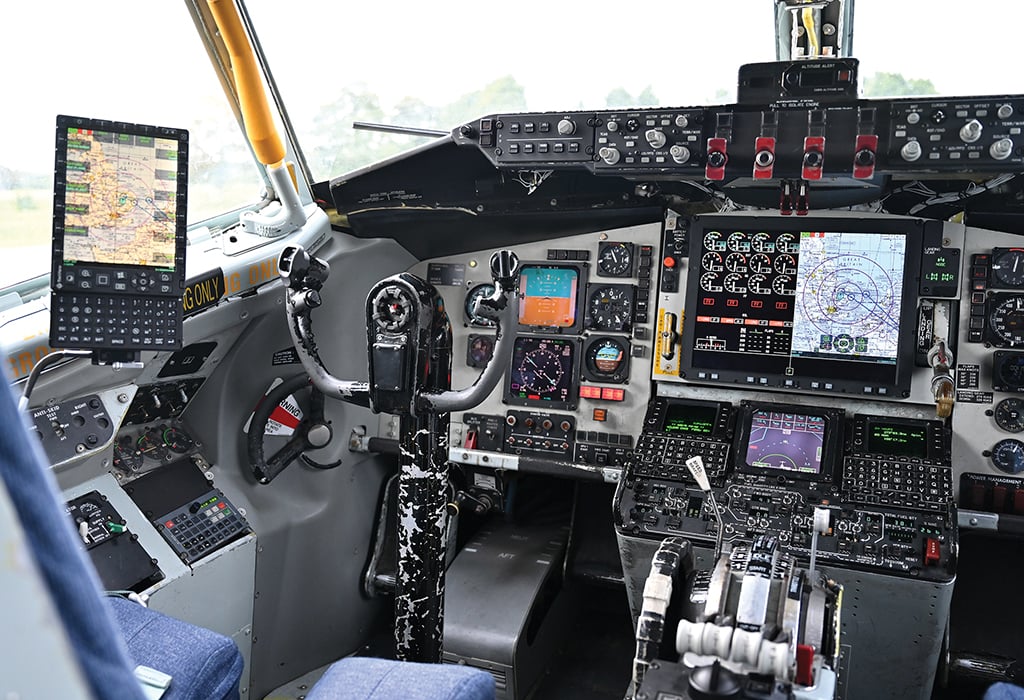This article is published in Aviation Week & Space Technology and is free to read until Jun 13, 2024. If you want to read more articles from this publication, please click the link to subscribe.

Training in the vastness of the Indo-Pacific region, a KC-135 from Alaska refueled a Northrop Grumman B-2 bomber en route to Australia.
As it faces a self-imposed deadline to be ready for a potential war with China in five years, the U.S. Air Force’s tanker fleet has a lot of work to do.
A next-generation tanker will not arrive for at least a decade. A 13-year acquisition program has delivered 82 Boeing KC-46 Pegasus tankers to date, but myriad unresolved issues have left most of them not fully mission capable. The most reliable refueling aircraft in the Air Mobility Command (AMC) fleet, the Boeing KC-10 Extender, will be retired before October. In the near term, the Air Force must rely on its 376 Boeing KC-135 Stratotankers, a fleet with an average age dating back to the Cuban Missile Crisis.
- The service plans connectivity and survivability upgrades
- Structural integrity remains a concern
“If we went to war today, the key refueling platform [would be] a 60-year-old tanker,” Kevin Stamey, director for Mobility and Training Aircraft, told an industry audience at Robins AFB in Georgia in late March. If the Stratotanker were a person, it would qualify to receive Social Security benefits.
As the most mature and available option, however, the KC-135 will have to do. That means the Air Force has a few years to upgrade the tanker to bolster its survivability and range while staving off the inevitable effects of the aging process on an airframe well into its seventh decade.
For most of its career, the KC-135’s connectivity has been limited to voice transmissions over line-of-sight radio links. Those communication systems are enough to coordinate refueling operations with other aircraft but fall short of the need in modern warfare. In a war with China, the Air Force expects tankers and the rest of the airlift fleet to become targets of long-range missile attacks. But the service’s mobility air crews have traditionally lacked access to secure communication once they have taken off.
“Most of our [Mobility Air Forces] platforms today, the first time they’ll know that a threat is coming at them is when they die,” Stamey said. “They’ll [also] find out that the runway that they thought they were going to be able to land on—because they’re about out of gas—they’ll know that it doesn’t exist when they’re on their approach. That is the wrong message to send our pilots, to go into conflict with no knowledge.”
An upgrade is partly addressing the issue. The Real-Time Information in the Cockpit program is equipping 326 KC-135s with Link 16. Installations for the active-duty KC-135 fleet will be completed by the end of fiscal 2027, according to justification documents submitted in March as part of the Air Force’s fiscal 2025 budget request. Link 16 will provide a secure narrowband channel to tactical aircraft, such as fighters, in communications range with a KC-135. Up to 313 KC-135s also are being connected to the satellite-provided Mobile User Objective System, enabling a secure narrowband link for beyond-line-of-sight communications.
But narrowband connections are no longer sufficient. A strike on a tanker implies a long-range enemy attack involving sensors, relays, missile launchers and the missile itself. To foil such an attack, a tanker needs to avoid or disrupt only one of the links in the long-range kill chain. The crew needs up-to-date information from a wide variety of sources, possibly requiring a large volume of data. Because of this, AMC is investigating options for secure wideband satellite connectivity.
The KC-135 Program Office hosted defense and industry representatives on April 2 to explain the proposed Commercial Access to Non-Secure Internet Protocol Router and Secure Internet Protocol Router program. The industry day event came after AMC submitted its own idea for implementing secure wideband satellite communications on the KC-135.

The Multi-Orbit Hardware Adaptable Wideband Kit (Mohawk) concept seeks to address the communications gap while avoiding locking the tanker fleet in with a single vendor for the long term. The project aims to install a payload fairing on top of the KC-135 fuselage, with the space and interfaces to accommodate several different antennas. The Air Force could use that to connect to SpaceX’s Starlink now or to competitors in the future.
The concept has raised concerns. Installing the radome and wire bundles for several different antennas could require drilling new openings into the top of the KC-135’s 62-year-old airframe.
“I really appreciate, conceptually, the idea of agility of Mohawk,” Stamey said. “What I don’t really like, frankly, is cutting irreversible holes in a perfectly good airplane. So what I’ve asked my industry partners to help me with is: How do I do this without cutting big holes in airplanes? Is there a smarter, more effective way to do this? And maybe the business case is just to put a singular Starlink antenna on. But what I’d really like to do is figure out how to do a conformal antenna where I just glue it on, and all I have to do is put a hole in the airplane [for] the wire bundle. Then I have a multifunction array that’s software-programmable.”
Concerns about negatively influencing the structural integrity of the KC-135 may seem overblown. The Stratotanker fleet still appears to be in its prime. In fiscal 2023, KC-135s offloaded nearly 65 million gal. of fuel to 38,360 aircraft. The aircraft are technically rated for 53,000 flight hours. Assuming they maintain an annual average of 900 flight hours, the fleet is expected to remain airworthy through 2053.
But the raw data disguises the effort required to sustain a fleet that predates the Lyndon Johnson administration. Aircraft are spending much longer than expected in the KC-135 heavy maintenance depots, Stamey said. More than 600 parts on the aircraft are no longer supported by the commercial supply chain.
In another presentation, to the Aerial Refueling Systems Advisory Group (ARSAG) on April 24, Stamey likened the sustainment phase of an aircraft program to the shape of a bathtub. During the early and later years of an aircraft’s life, sustainment costs are at their peak. In between, costs are low and stable.
“Honestly, there’s only so much we can do to hold off the inevitable climb of KC-135 up the backside of that bathtub curve,” Stamey told the ARSAG audience.
Aircraft availability levels are a top concern across the mobility and training aircraft fleets, he said. But budget pressures mean little relief is expected to come from higher spending on upgrades intended to lower maintenance costs.
“Every one of my platforms is below their required aircraft availability,” Stamey noted. “But looking at the budget, unfortunately, we are not going to get a windfall of cash to go solve my aircraft availability problems, and so throwing more money at it can’t be the answer. So I’ve got to find innovative ways to address our [highest-priority] ‘A’ challenges.”
Some of the innovations coming to the KC-135 are focused on improving fuel efficiency. If a tanker consumes less fuel, it will have more to offload to a receiver or to enable it to remain airborne longer. Funded upgrades also are planned to equip the KC-135 fleet with new winglets and replace horizontal windshield wipers with drag-reducing, vertical devices.
Editor's note: This article was updated to correct the number of KC-135 parts that are no longer supported by the commercial supply chain.



